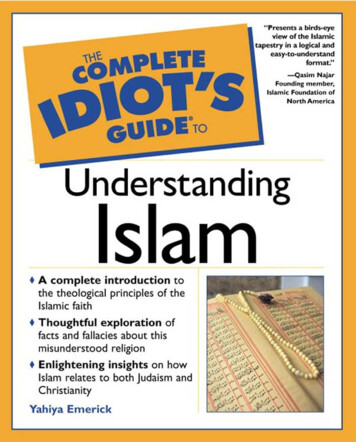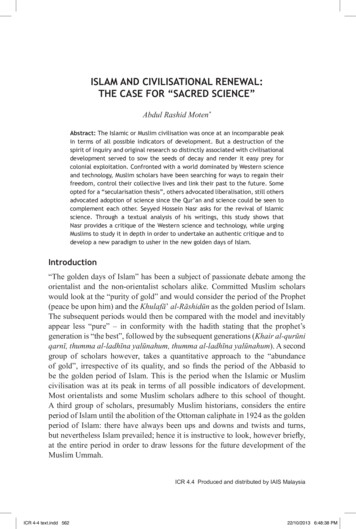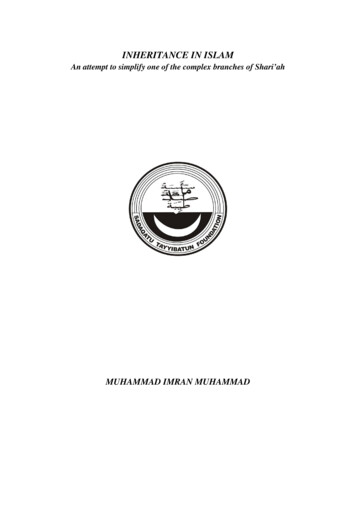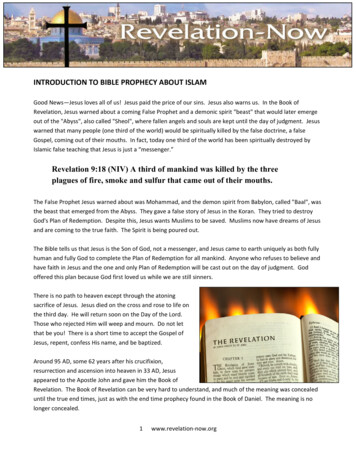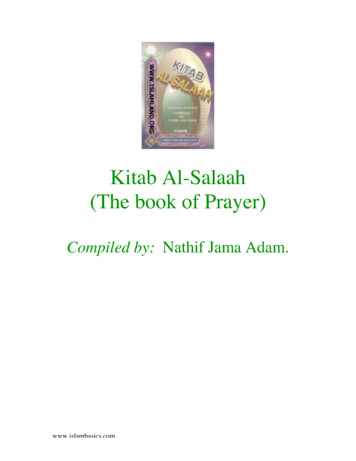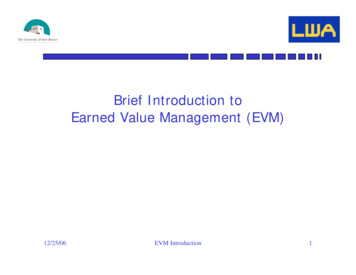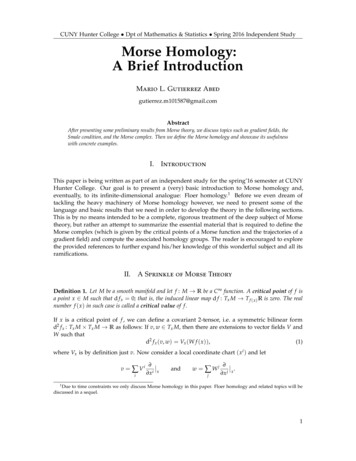
Transcription
BRIEF INTRODUCTION TO ISLAMSince the 11 September 2001, the Islamic religion grows very fast. Today,almost the quarter of the world's population is Muslim. Millions of Muslimsin the world pray five times a day in direction of the Islamic Holy City, calledMeccah. A city from Saudi Arabia, where Islamic religion was revealed in622 AC to Muhammad the prophet of Islam.Muslims worship five times a day “the house of Allah” called the Kaaba: amysterious black cube inside the sacred mosque of Meccah.This is the Kaaba, the Sanctuary of ALLAH, inside the Highest Spiritualcenter of Islam, Meccah.THE PAGAN ROOTS OF ISLAM IN INDIA AND MIDDLE EASTRamadan's Roots (The Holy month of Islam). [1][1] Source ReligionResearchInstitute.org - Dr. Rafat Amari3
Ramadan, the ninth month of the Islamic calendar and the rigidobservance of thirty days of fasting during the daylight hours, has paganroots developed in India and the Middle East. The observance of fasting tohonor the moon, and ending the fast when the moon's crescent appears,was practiced with the rituals of the Eastern worshippers of the moon.Both Ibn al-Nadim and the Shahrastani tell us about al-Jandrikinieh, anIndian sect which began to fast when the moon disappeared and endedthe fast with a great feast when the crescent reappeared.The Sabians, who were pagans in the Middle East, were identified withtwo groups, the Mandaeans and the Harranians. The Mandaeans lived inIraq during the 2nd century A.D. As they continue to do today, theyworshipped multiple gods, or “light personalities.” Their gods wereclassified under four categories: “first life,” “second life,” “third life” and“fourth life.” Old gods belong to the “first life” category. They summoneddeities who, in turn, created “second life” deities, and so forth.The othergroup, considered as Sabians, were the Harranians. They worshippedSin, the moon, as their main deity, but they also worshipped planets andother deities.The Sabians were in contact with Ahnaf, an Arabian group whichMohammed joined before claiming to be a prophet. Ahnaf soughtknowledge by going to Northern Iraq, where there were manycommunities of Mandaeans. They also went to the city of Harran in the alJazirah district in northern Syria on the border between Syria, Iraq andAsia Minor.In Mecca, the Ahnaf were called Sabians because of the doctrines theyembraced. Later, when Mohammed claimed to be a prophet, he wascalled a Sabian by the inhabitants of Mecca because they saw himperforming many Sabian rites which included praying five times a day;performing several movements in prayer that were identical with theMandaeans and the Harranians; and making ablution, or ceremonialwashing, before each prayer.Ramadan was a pagan ceremony practiced by the Sabians, whether theywere Harranians or Sabians. From the writings of Abu Zanad, an Arabicwriter from Iraq who lived around 747 A.D., we conclude that at least oneMandaean community located in northern Iraq observed Ramadan.Ramadan was originally an Annual Ritual Performed at the City of Harran.Similarities between the Ramadan of Harran and the Islamic Ramadan.Although the fasting of Ramadan was practiced in pre-Islamic times bythe pagans of Jahiliyah, it was introduced to Arabia by the Harranians.Harran was a city on the border between Syria and Iraq, very close to4
Asia Minor which, today, is Turkey. Their main deity was the moon, and inthe worship of the moon, they conducted a major fast which lasted thirtydays. It began the eighth of March and usually finished the eighth of April.Arabic historians, such as IbnHazm, identify this fast with Ramadan.Ibn al-Nadim wrote in his book, al-Fahrisit, about various religious sects inthe Middle East. He says in the month in which the Harranians fasted forthirty days, they honored the god Sin, which is the moon. Al-Nadimdescribed the feasts they celebrated and the sacrifices they presented tothe moon. Another historian, Ibn Abi Zinad also speaks about theHarranians, saying that they fast for thirty days, they look toward Yemenwhen they fast, and they pray five times a day. We know that Muslims alsopray five times a day. Harranian fasting is also similar to that of Ramadanin Islam in the fact that they fast from before the sun rises until the sunset,just as the Muslims do during the days of Ramadan. Still anotherhistorian, Ibn al-Juzi, described the Harranian fasting during this month.He said they concluded their fasting by sacrificing animals and presentingalms to the poor. We also find these things in Islamic fasting today.( ) In addition to the feast during Ramadan, the Harranians had fiveprayers which they repeated day and night. Each had to be preceded byablutions, whichwere ceremonial washings. The same system of fiveprayers each day, preceded by ablutions, was embraced by Mohammed.Was the Kaaba of Meccah originally a Hindu Temple?The Kaaba of Azerbaijan was an ancient Hindu Religious Shrine. Here'san inscription from the Baku (Kaaba) Atashgah: the first line begins: Isalute Lord Ganesh ( ी गणेसाय नम), the second venerates the holy fire(जवालाजी, Jwala Ji) and dates the inscription to Samvat 1802 (संवत १८०२, or1745-46 CE). The Persian quatrain below is the sole Persian inscriptionon the temple and, though ungrammatical, also refers to the fire ( )آﺗــــــــش and dates it to 1158 (١١٥٨) Hijri, which is also 1745 CE. [1]A recent archeological find in Kuwait unearthed a gold-plated statue ofthe Hindu deity Ganesh. A Muslim resident of Kuwait requested historicalresearch material that can help explain the connection between Hinducivilisation and Arabia.Glancing through some research material recently, an archaeologist waspleasantly surprised to come across a reference to a king Vikramadityainscription found in the Kaaba in Mecca proving beyond doubt that theArabian Peninsula formed a part of his Indian Empire. The text of the[1] Jackson, Abraham Valentine Williams (1911), "The Oil Fields and Fire Temple Baku"53
crucial Vikramaditya inscription, found inscribed on a gold dish hunginside the Kaaba shrine in Mecca, is found recorded on page 315 of avolume known as 'Sayar-ul-Okul' treasured in the Makhtab-e-Sultanialibrary in Istanbul, Turkey. [1][1][2]Picture of the Hindu God Shiva.THE CONNECTIONS BETWEEN ISLAM AND THE CRESCENT MOONThe religion of Islam has as its focus of worship a deity by the name of"Allah." The Muslims claim that Allah in pre-Islamic times was the biblicalGod of the Patriarchs, prophets, and apostles. The issue is thus one ofcontinuity. Was "Allah" the biblical God or a pagan god in Arabia duringpre-Islamic times?The Muslim's claim of continuity is essential to their attempt to convertJews and Christians for if "Allah" is part of the flow of divine revelation inScripture, then it is the next step in biblical religion. Thus we should allbecome Muslims. But, on the other hand, if Allah was a pre-Islamicpagan deity, then its core claim is refuted. Religious claims often fallbefore the results of hard sciences such as archeology. We canendlessly speculate about the past or go and dig it up and see what theevidence reveals. This is the only way to find out the truth concerning theorigins of Allah. As we shall see, the hard evidence demonstrates that thegod Allah was a pagan deity. In fact, he was the Moon-god who wasmarried to the sun goddess and the stars were his daughters.6
Archaeologists have uncovered temples to the Moon-god throughout theMiddle East. From the mountains of Turkey to the banks of the Nile, themost wide-spread religion of the ancient world was the worship of theMoon-god. In the first literate civilization, the Sumerians have left usthousands of clay tablets in which they described their religious beliefs.As demonstrated by Sjoberg and Hall, the ancient Sumeriansworshipped a Moon-god who was called many different names. Themost popular names were Nanna, Suen and Asimbabbar. His symbolwas the crescent moon. Given the amount of artifacts concerning theworship of this Moon-god, it is clear that this was the dominant religion inSumeria. The cult of the Moon-god was the most popular religionthroughout ancient Mesopotamia. The Assyrians, Babylonians, and theAkkadians took the word Suen and transformed it into the word Sin astheir favorite name for the Moon-God. As Prof. Potts pointed out, "Sin is aname essentially Sumerian in origin which had been borrowed by theSemites".In the 1950's a major temple to the Moon-god was excavated at Hazer inPalestine. Two idols of the moon god were found. Each was a stature of aman sitting upon a throne with a crescent moon carved on his chest. Theaccompanying inscriptions make it clear that these were idols of theMoon-god. Several smaller statues were also found which wereidentified by their inscriptions as the "daughters" of the Moon-god. Whatabout Arabia? As pointed out by Prof. Coon, "Muslims are notoriouslyloath to preserve traditions of earlier paganism and like to garble whatpre-Islamic history they permit to survive in anachronistic terms".During the nineteenth century, Thousands of inscriptions from walls androcks in Northern Arabia have also been collected. Reliefs and votivebowls used in worship of the "daughters of Allah" have also beendiscovered. The three daughters, al-Lat, al-Uzza and Manat aresometimes depicted together with Allah the Moon-god represented by acrescent moon above them. The archeological evidence demonstratesthat the dominant religion of Arabia was the cult of the Moon-god.In Old Testament times, Nabonidus (555-539 B.C.), the last king ofBabylon, built Tayma, Arabia as a center of Moon-god worship. Segallstated, "South Arabia's stellar religion has always been dominated by theMoon-god in various variations." Many scholars have also noticed thatthe Moon-god's name "Sin" is a part of such Arabic words as "Sinai", the"wilderness of Sin", etc. When the popularity of the Moon-god wanedelsewhere, the Arabs remained true to their conviction that the Moon-godwas the greatest of all gods. While they worshipped 360 gods at theKabah in Mecca, the Moon-god was the chief deity. Mecca was in factbuilt as a shrine for the Moon-god.In 1944, G. Caton Thompson revealed in her book, The Tombs and Moon7
Temple of Hureidha, that she had uncovered a temple of the Moon-god insouthern Arabia. The symbols of the crescent moon and no less thantwenty-one inscriptions with the name Sin were found in this temple. Anidol which may be the Moon-god himself was also discovered. This waslater confirmed by other well-known archeologists.The evidence reveals that the temple of the Moon-god was active even inthe Christian era. Evidence gathered from both North and South Arabiademonstrates that Moon-god worship was clearly active even inMuhammad's day and was still the dominant cult. According to numerousinscriptions, while the name of the Moon-god was Sin, his title was alilah, i.e. "the deity," meaning that he was the chief or high god among thegods. As Coon pointed out, "The god Il or Ilah was originally a phase ofthe Moon God." The Moon-god was called Al-Ilah, i.e. the god, which wasshortened to Allah in pre-Islamic times. The pagan Arabs even used Allahin the names they gave to their children. For example, both Muhammad'sfather and uncle had Allah as part of their names.The fact that they were given such names by their pagan parents provesthat Allah was the title for the Moon-god even in Muhammad's day. Prof.Coon goes on to say, "Similarly, under Mohammed's tutelage, the relativelyanonymous Ilah, became Al-Ilah, The God, or Allah, the Supreme Being".This fact answers the questions, "Why is Allah never defined in theQur'an? Why did Muhammad assume that the pagan Arabs alreadyknew who Allah was?" Muhammad was raised in the religion of the Moongod Allah. But he went one step further than his fellow pagan Arabs.While they believed that Allah, i.e. the Moon-god, was the greatest of allgods and the supreme deity in a pantheon of deities, Muhammaddecided that Allah was not only the greatest god but the only god.In effect he said, "Look, you already believe that the Moon-god Allah isthe greatest of all gods. All I want you to do is to accept that the idea thathe is the only god. I am not taking away the Allah you already worship. Iam only taking away his wife and his daughters and all the other gods."This is seen from the fact that the first point of the Muslim creed is not,"Allah is great" but "Allah is the greatest," i.e., he is the greatest amongthe gods. Why would Muhammad say that Allah is the "greatest" exceptin a polytheistic context? The Arabic word is used to contrast the greaterfrom the lesser. That this is true is seen from the fact that the pagan Arabsnever accused Muhammad of preaching a different Allah than the onethey already worshipped. This "Allah" was the Moon-god according tothe archeological evidence. Muhammad thus attempted to have it bothways. To the pagans, he said that he still believed in the Moon-god Allah.To the Jews and the Christians, he said that Allah was their God too. Butboth the Jews and the Christians knew better and that is why theyrejected his god Allah as a false god.8
Al-Kindi, one of the early Christian apologists against Islam, pointed outthat Islam and its god Allah did not come from the Bible but from thepaganism of the Sabeans. They did not worship the God of the Bible butthe Moon-god and his daughters al-Uzza, al-Lat and Manat. Dr. Newmanconcludes his study of the early Christian-Muslim debates by stating,"Islam proved itself to be a separate and antagonistic religion which hadsprung up from idolatry." Islamic scholar Caesar Farah concluded "There isno reason, therefore, to accept the idea that Allah passed to the Muslimsfrom the Christians and Jews." The Arabs worshipped the Moon-god as asupreme deity. But this was not biblical monotheism. While the Moon-godwas greater than all other gods and goddesses, this was still a polytheisticpantheon of deities. Now that we have the actual idols of the
Muslims worship five times a day “the house of Allah” called the Kaaba: a mysterious black cube inside the sacred mosque of Meccah. This is the Kaaba, the Sanctuary of ALLAH, inside the Highest Spiritual center of Islam, Meccah. THE PAGAN ROOTS OF ISLAM IN INDIA AND MIDDLE EAST Ramadan's Roots (The Holy month of Islam). [1]

